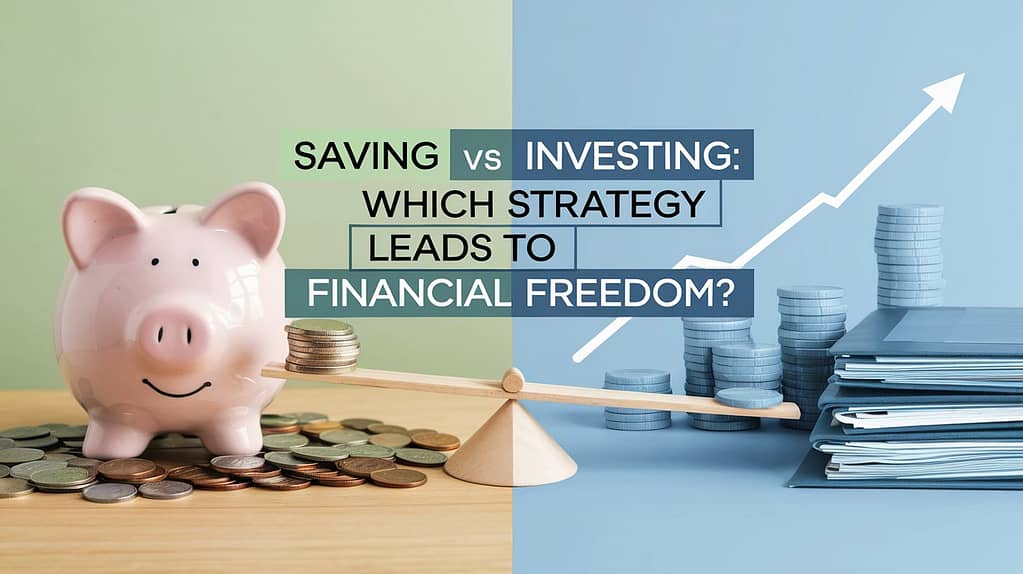
Introduction
When it comes to achieving financial freedom, the debate often boils down to saving vs investing. Both strategies have merits, but the choice depends on your financial goals, risk tolerance, and time horizon. Consider saving as planting a tree for shade, while investing is planting an orchard for future fruit. But which strategy is right for you, and how can you effectively use both to secure your financial future? Let’s dive into the details.
Table of Contents
What is Saving?
Definition and Purpose of Saving
Saving is the act of setting aside money for future use, typically in low-risk, highly liquid accounts. It’s the cornerstone of any financial plan, ensuring you’re prepared for unexpected expenses or short-term goals.
Benefits of Saving
Emergency Fund Creation
Savings act as your safety net, ensuring you’re prepared for emergencies like medical bills or car repairs without resorting to debt.
Peace of Mind and Liquidity
Having readily accessible funds provides financial stability and reduces stress, offering the freedom to make decisions without monetary constraints.
Common Saving Tools
- Savings Accounts: Ideal for keeping funds secure and earning modest interest.
- Fixed Deposits: Offer higher interest rates for locking in your funds.
- Money Market Accounts: Provide a balance of liquidity and slightly better returns than regular savings accounts.
What is Investing?
Definition and Purpose of Investing
Investing involves allocating money to assets like stocks, bonds, or real estate to grow wealth over time. Unlike saving, investing carries risk but offers the potential for higher returns.
Benefits of Investing
Wealth Accumulation
Investing allows your money to work for you, growing exponentially over time through compound interest or capital gains.
Combatting Inflation
While savings may lose value over time due to inflation, investments often outpace inflation, preserving and growing purchasing power.
Common Investment Vehicles
- Stocks and Bonds: Provide ownership in companies or lend money to earn interest.
- Real Estate: A tangible asset with potential for rental income and appreciation.
- Mutual Funds and ETFs: Diversified investment options managed by professionals.
Best Platforms I Can Recommend For You
The Key Differences Between Saving and Investing
Risk and Reward
Savings offer security but limited growth, while investments come with risks and potentially higher rewards.
Time Horizon
Savings are suitable for short-term goals, while investments are better for long-term objectives like retirement.
Liquidity
Savings are easily accessible, whereas investments might take time to convert to cash.
Pros and Cons of Saving
Advantages of Saving
- Safe and secure.
- Provides immediate access to funds.
- Easy to set up and manage.
Disadvantages of Saving
- Limited growth potential.
- Vulnerable to inflation over time.
Pros and Cons of Investing
Advantages of Investing
- High potential for wealth creation.
- Diversification reduces risk over time.
- Effective against inflation.
Disadvantages of Investing
- Involves risk, including potential loss of principal.
- Requires knowledge and research.
- Returns may take time to realize.
When Should You Save?
Short-Term Financial Goals
If you’re planning for expenses like a vacation or buying a car within the next few years, saving is your best bet.
Emergency Preparedness
Start by building a fund that can cover 3-6 months of living expenses.
Predictable Expenses
For costs like education or weddings, saving ensures you meet your goals without financial stress.
When Should You Invest?
Long-Term Financial Goals
Investments are ideal for goals like buying a home or funding a child’s education, which requires significant growth over time.
Building Wealth
If you want to create generational wealth, investing is a powerful tool.
Retirement Planning
The earlier you start investing for retirement, the more you can benefit from compound interest.
How to Balance Saving and Investing
Assessing Your Financial Goals
Define your short-term and long-term objectives to allocate resources effectively.
Creating a Budget
Set aside specific percentages of your income for saving and investing.
Prioritizing an Emergency Fund
Build a solid savings base before venturing into higher-risk investments.
Diversification for Financial Growth
A balanced portfolio with savings for security and investments for growth offers the best of both worlds.
Conclusion
Saving and investing are not mutually exclusive; they complement each other in your journey toward financial freedom. Savings provide stability and immediate access to funds, while investments offer the potential for long-term growth. By understanding your goals and risk tolerance, you can create a strategy that secures both your present and future.
FAQs
1. What percentage of income should I save vs. invest?
A common rule of thumb is the 50/30/20 rule: allocate 20% of your income to savings and investments combined, adjusting based on your goals.
2. Can I start investing with a small amount of money?
Yes! Platforms like robo-advisors and micro-investing apps make it easy to start with as little as $5.
3. How do I decide my financial priorities?
Begin by listing your short-term and long-term goals, then allocate resources accordingly, ensuring an emergency fund comes first.
4. Is investing risky for beginners?
While there are risks, starting with low-risk investments like index funds can ease you into the process.
5. What tools can help me track savings and investments?
Use apps like Mint, Personal Capital, or YNAB to monitor your financial health in real time.

